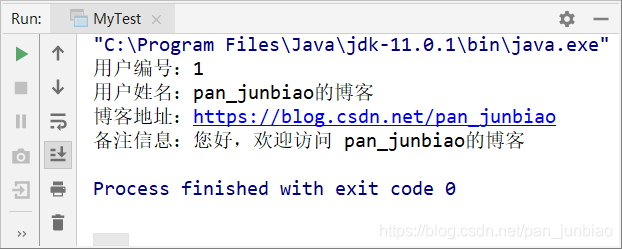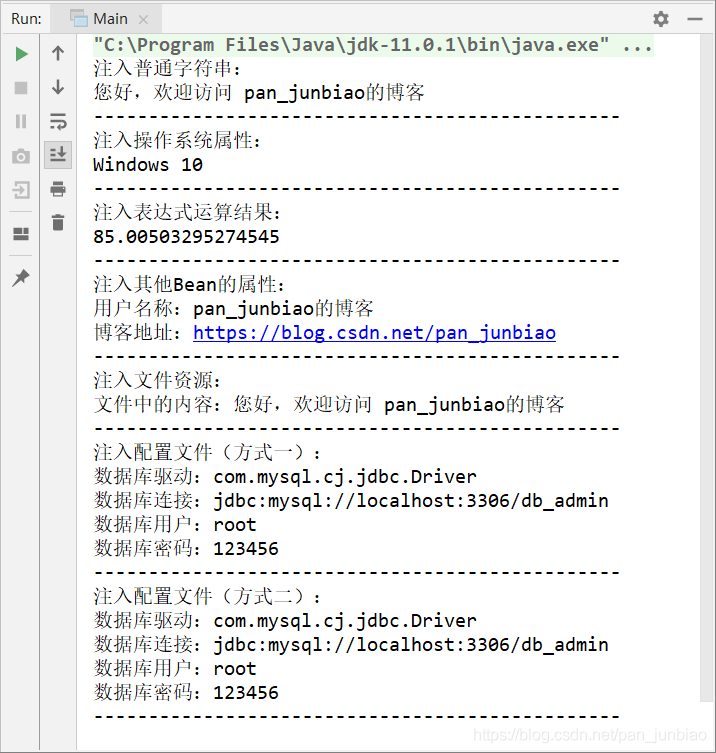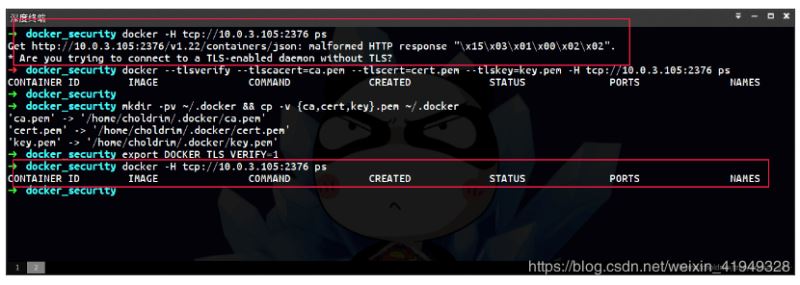Spring使用@Value注解与@PropertySource注解加载配置文件操作
Spring框架提供的@Value注解可以将外部的值动态注入到Bean中,@Value注解使用在字段、构造器参数和方法参数上。
@Value可以指定属性取值的表达式,支持通过#{}使用SpringEL来取值,也支持使用${}来将属性来源中(Properties文件、本地环境变量、系统属性等)的值注入到Bean的属性中。
此注解值的注入发生在AutowiredAnnotationBeanPostProcessor类中。
@Value注解实现以下几种情况:
(1)注入普通字符;
(2)注入操作系统属性;
(3)注入表达式运算结果;
(4)注入其他Bean的属性;
(5)注入文件内容;
(6)注入网址内容;
(7)注入属性文件。
2、@PropertySource注解简介@PropertySource注解可以加载指定的属性文件(*.properties)到 Spring 的 Environment 中。可以配合 @Value 和 @ConfigurationProperties 使用。语法格式如下:
@PropertySource(value = 'classpath:com/pjb/el/user.properties',encoding = 'UTF-8')public class UserInfo{}
【实例】使用@Value注解与@PropertySource注解加载配置文件。
(1)创建用户信息属性文件(user.properties)user.userId=1user.userName=pan_junbiao的博客user.blogUrl=https://blog.csdn.net/pan_junbiaouser.remark=您好,欢迎访问 pan_junbiao的博客(2)创建用户信息实体类(UserInfo.java)
使用@PropertySource注解加载配置文件信息,然后使用@Value注解注入属性值。
package com.pjb.el;import org.springframework.beans.factory.annotation.Value;import org.springframework.context.annotation.PropertySource;import org.springframework.stereotype.Component; /** * 用户信息实体类 * @author pan_junbiao **/@Component@PropertySource(value = 'classpath:com/pjb/el/user.properties',encoding = 'UTF-8')public class UserInfo{ //用户ID @Value('${user.userId}') private int userId; //用户姓名 @Value('${user.userName}') private String userName; //博客地址 @Value('${user.blogUrl}') private String blogUrl; //备注 @Value('${user.remark}') private String remark; //省略getter与setter方法...}(3)运行
public static void main(String[] args){ AnnotationConfigApplicationContext context = new AnnotationConfigApplicationContext(ElConfig.class); UserInfo userInfo = context.getBean(UserInfo.class); //打印用户信息 System.out.println('用户编号:' + userInfo.getUserId()); System.out.println('用户姓名:' + userInfo.getUserName()); System.out.println('博客地址:' + userInfo.getBlogUrl()); System.out.println('备注信息:' + userInfo.getRemark());}
执行结果:

【实例】使用@Value注解实现多种情况值的注入和@PropertySource注解加载配置文件。
(1)添加相关的jar包添加Spring支持及commons-io依赖,pom.xml文件的配置如下:
<properties> <project.build.sourceEncoding>UTF-8</project.build.sourceEncoding> <spring.version>5.2.3.RELEASE</spring.version></properties> <dependencies> <!-- Spring框架 --> <dependency><groupId>org.springframework</groupId><artifactId>spring-core</artifactId><version>${spring.version}</version> </dependency> <dependency><groupId>org.springframework</groupId><artifactId>spring-context</artifactId><version>${spring.version}</version> </dependency> <!-- commons-io依赖 --> <dependency><groupId>commons-io</groupId><artifactId>commons-io</artifactId><version>2.6</version> </dependency></dependencies>
添加 commons-io.jar 可以简化文件相关操作,本实例中使用 commons-io 将 file 转换成字符串。
(2)创建资源文件在resources资源目录下创建名称为info.txt的文本文件,文件内容为:您好,欢迎访问 pan_junbiao的博客。
在resources资源目录下创建数据库连接配置文件db.properties,该文件配置如下:
jdbc.driver=com.mysql.cj.jdbc.Driverjdbc.url=jdbc:mysql://localhost:3306/db_adminjdbc.username=rootjdbc.password=123456(3)需被注入的Bean
创建名为OtherUser.java的用户信息类。
package com.pjb.el;import org.springframework.beans.factory.annotation.Value;import org.springframework.stereotype.Component; /** * 用户信息类 * @author pan_junbiao **/@Componentpublic class OtherUser{ //用户名称 @Value('pan_junbiao的博客') private String userName; //博客地址 @Value('https://blog.csdn.net/pan_junbiao') private String blogUrl; public String getUserName() {return userName; } public void setUserName(String userName) {this.userName = userName; } public String getBlogUrl() {return blogUrl; } public void setBlogUrl(String blogUrl) {this.blogUrl = blogUrl; }}(4)配置类
创建名为ElConfig.java的配置类。
package com.pjb.el;import org.apache.commons.io.IOUtils;import org.springframework.beans.factory.annotation.Autowired;import org.springframework.beans.factory.annotation.Value;import org.springframework.context.annotation.Bean;import org.springframework.context.annotation.ComponentScan;import org.springframework.context.annotation.Configuration;import org.springframework.context.annotation.PropertySource;import org.springframework.context.support.PropertySourcesPlaceholderConfigurer;import org.springframework.core.env.Environment;import org.springframework.core.io.Resource; /** * 配置类 * @author pan_junbiao **/@Configuration@ComponentScan('com.pjb.el')@PropertySource('classpath:db.properties')public class ElConfig{ /** * 注入普通字符串 */ @Value('您好,欢迎访问 pan_junbiao的博客') private String comment; /** * 注入操作系统属性 */ @Value('#{systemProperties[’os.name’]}') private String osName; /** * 注入表达式运算结果 */ @Value('#{ T(java.lang.Math).random() * 100.0 }') private double randomNumber; /** * 注入其他Bean的属性 */ @Value('#{otherUser.userName}') private String fromUserName; @Value('#{otherUser.blogUrl}') private String fromBlogUrl; /** * 注入文件资源 */ @Value('classpath:info.txt') private Resource testFile; /** * 注入网址资源 */ @Value('https://blog.csdn.net/pan_junbiao') private Resource testUrl; /** * 注入配置文件 */ @Value('${jdbc.driver}') private String jdbc_driver; @Value('${jdbc.url}') private String jdbc_url; @Value('${jdbc.username}') private String jdbc_username; @Value('${jdbc.password}') private String jdbc_password; @Autowired private Environment environment; @Bean public static PropertySourcesPlaceholderConfigurer propertyConfigurer() {return new PropertySourcesPlaceholderConfigurer(); } public void outputResource() {try{ System.out.println('注入普通字符串:'); System.out.println(comment); System.out.println('------------------------------------------------'); System.out.println('注入操作系统属性:'); System.out.println(osName); System.out.println('------------------------------------------------'); System.out.println('注入表达式运算结果:'); System.out.println(randomNumber); System.out.println('------------------------------------------------'); System.out.println('注入其他Bean的属性:'); System.out.println('用户名称:' + fromUserName); System.out.println('博客地址:'+ fromBlogUrl); System.out.println('------------------------------------------------'); System.out.println('注入文件资源:'); System.out.println('文件中的内容:' + IOUtils.toString(testFile.getInputStream())); System.out.println('------------------------------------------------'); System.out.println('注入配置文件(方式一):'); System.out.println('数据库驱动:' + jdbc_driver); System.out.println('数据库连接:' + jdbc_url); System.out.println('数据库用户:' + jdbc_username); System.out.println('数据库密码:' + jdbc_password); System.out.println('------------------------------------------------'); System.out.println('注入配置文件(方式二):'); System.out.println('数据库驱动:' + environment.getProperty('jdbc.driver')); System.out.println('数据库连接:' + environment.getProperty('jdbc.url')); System.out.println('数据库用户:' + environment.getProperty('jdbc.username')); System.out.println('数据库密码:' + environment.getProperty('jdbc.password')); System.out.println('------------------------------------------------');}catch (Exception ex){ ex.printStackTrace();} }}
注入配置配件需要使用@PropertySource注解指定文件地址,若使用@Value注解,则要配置一个PropertySourcesPlaceholderConfigurer的Bean。注意,@Value('${jdbc.driver}')使用的是“${}”而不是“#{}”。
注入Properties还可以从Environment中获得。
(5)运行package com.pjb.el;import org.springframework.context.annotation.AnnotationConfigApplicationContext; /** * 运行类 * @author pan_junbiao **/public class Main{ public static void main(String[] args) {AnnotationConfigApplicationContext context = new AnnotationConfigApplicationContext(ElConfig.class);ElConfig resourceService = context.getBean(ElConfig.class);resourceService.outputResource();context.close(); }}
执行结果:

@value需要参数,这里参数可以是两种形式:
@Value(“#{configProperties[‘t1.msgname’]}”)
或者
@Value(“${t1.msgname}”);其次
下面我们来看看如何使用这两形式,在配置上有什么区别:
1、@Value(“#{configProperties[‘t1.msgname’]}”)这种形式的配置中有“configProperties”,其实它指定的是配置文件的加载对象:配置如下:
classpath:/config/t1.properties
这样配置就可完成对属性的具体注入了;
2、@Value('${t1.msgname}')这种形式不需要指定具体加载对象,这时候需要一个关键的对象来完成PreferencesPlaceholderConfigurer,这个对象的配置可以利用上面配置1中的配置,也可以自己直接自定配置文件路径。
如果使用配置1中的配置,可以写成如下情况:
<bean class='org.springframework.beans.factory.config.PreferencesPlaceholderConfigurer'> <property name='properties' ref='configProperties'/></bean>
如果直接指定配置文件的话,可以写成如下情况:
<bean class='org.springframework.beans.factory.config.PreferencesPlaceholderConfigurer'> <property name='location'> <value>config/t1.properties</value> </property></bean>**重点内容**
以上为个人经验,希望能给大家一个参考,也希望大家多多支持好吧啦网。
相关文章:

 网公网安备
网公网安备